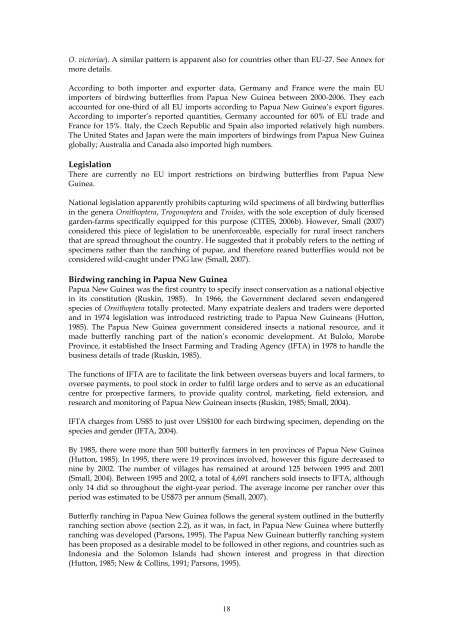review of trade in ranched birdwing butterflies - UNEP World ...
review of trade in ranched birdwing butterflies - UNEP World ...
review of trade in ranched birdwing butterflies - UNEP World ...
You also want an ePaper? Increase the reach of your titles
YUMPU automatically turns print PDFs into web optimized ePapers that Google loves.
O. victoriae). A similar pattern is apparent also for countries other than EU-27. See Annex for<br />
more details.<br />
Accord<strong>in</strong>g to both importer and exporter data, Germany and France were the ma<strong>in</strong> EU<br />
importers <strong>of</strong> birdw<strong>in</strong>g <strong>butterflies</strong> from Papua New Gu<strong>in</strong>ea between 2000-2006. They each<br />
accounted for one-third <strong>of</strong> all EU imports accord<strong>in</strong>g to Papua New Gu<strong>in</strong>ea‟s export figures.<br />
Accord<strong>in</strong>g to importer‟s reported quantities, Germany accounted for 60% <strong>of</strong> EU <strong>trade</strong> and<br />
France for 15%. Italy, the Czech Republic and Spa<strong>in</strong> also imported relatively high numbers.<br />
The United States and Japan were the ma<strong>in</strong> importers <strong>of</strong> birdw<strong>in</strong>gs from Papua New Gu<strong>in</strong>ea<br />
globally; Australia and Canada also imported high numbers.<br />
Legislation<br />
There are currently no EU import restrictions on birdw<strong>in</strong>g <strong>butterflies</strong> from Papua New<br />
Gu<strong>in</strong>ea.<br />
National legislation apparently prohibits captur<strong>in</strong>g wild specimens <strong>of</strong> all birdw<strong>in</strong>g <strong>butterflies</strong><br />
<strong>in</strong> the genera Ornithoptera, Trogonoptera and Troides, with the sole exception <strong>of</strong> duly licensed<br />
garden-farms specifically equipped for this purpose (CITES, 2006b). However, Small (2007)<br />
considered this piece <strong>of</strong> legislation to be unenforceable, especially for rural <strong>in</strong>sect ranchers<br />
that are spread throughout the country. He suggested that it probably refers to the nett<strong>in</strong>g <strong>of</strong><br />
specimens rather than the ranch<strong>in</strong>g <strong>of</strong> pupae, and therefore reared <strong>butterflies</strong> would not be<br />
considered wild-caught under PNG law (Small, 2007).<br />
Birdw<strong>in</strong>g ranch<strong>in</strong>g <strong>in</strong> Papua New Gu<strong>in</strong>ea<br />
Papua New Gu<strong>in</strong>ea was the first country to specify <strong>in</strong>sect conservation as a national objective<br />
<strong>in</strong> its constitution (Rusk<strong>in</strong>, 1985). In 1966, the Government declared seven endangered<br />
species <strong>of</strong> Ornithoptera totally protected. Many expatriate dealers and <strong>trade</strong>rs were deported<br />
and <strong>in</strong> 1974 legislation was <strong>in</strong>troduced restrict<strong>in</strong>g <strong>trade</strong> to Papua New Gu<strong>in</strong>eans (Hutton,<br />
1985). The Papua New Gu<strong>in</strong>ea government considered <strong>in</strong>sects a national resource, and it<br />
made butterfly ranch<strong>in</strong>g part <strong>of</strong> the nation‟s economic development. At Bulolo, Morobe<br />
Prov<strong>in</strong>ce, it established the Insect Farm<strong>in</strong>g and Trad<strong>in</strong>g Agency (IFTA) <strong>in</strong> 1978 to handle the<br />
bus<strong>in</strong>ess details <strong>of</strong> <strong>trade</strong> (Rusk<strong>in</strong>, 1985).<br />
The functions <strong>of</strong> IFTA are to facilitate the l<strong>in</strong>k between overseas buyers and local farmers, to<br />
oversee payments, to pool stock <strong>in</strong> order to fulfil large orders and to serve as an educational<br />
centre for prospective farmers, to provide quality control, market<strong>in</strong>g, field extension, and<br />
research and monitor<strong>in</strong>g <strong>of</strong> Papua New Gu<strong>in</strong>ean <strong>in</strong>sects (Rusk<strong>in</strong>, 1985; Small, 2004).<br />
IFTA charges from US$5 to just over US$100 for each birdw<strong>in</strong>g specimen, depend<strong>in</strong>g on the<br />
species and gender (IFTA, 2004).<br />
By 1985, there were more than 500 butterfly farmers <strong>in</strong> ten prov<strong>in</strong>ces <strong>of</strong> Papua New Gu<strong>in</strong>ea<br />
(Hutton, 1985). In 1995, there were 19 prov<strong>in</strong>ces <strong>in</strong>volved, however this figure decreased to<br />
n<strong>in</strong>e by 2002. The number <strong>of</strong> villages has rema<strong>in</strong>ed at around 125 between 1995 and 2001<br />
(Small, 2004). Between 1995 and 2002, a total <strong>of</strong> 4,691 ranchers sold <strong>in</strong>sects to IFTA, although<br />
only 14 did so throughout the eight-year period. The average <strong>in</strong>come per rancher over this<br />
period was estimated to be US$73 per annum (Small, 2007).<br />
Butterfly ranch<strong>in</strong>g <strong>in</strong> Papua New Gu<strong>in</strong>ea follows the general system outl<strong>in</strong>ed <strong>in</strong> the butterfly<br />
ranch<strong>in</strong>g section above (section 2.2), as it was, <strong>in</strong> fact, <strong>in</strong> Papua New Gu<strong>in</strong>ea where butterfly<br />
ranch<strong>in</strong>g was developed (Parsons, 1995). The Papua New Gu<strong>in</strong>ean butterfly ranch<strong>in</strong>g system<br />
has been proposed as a desirable model to be followed <strong>in</strong> other regions, and countries such as<br />
Indonesia and the Solomon Islands had shown <strong>in</strong>terest and progress <strong>in</strong> that direction<br />
(Hutton, 1985; New & Coll<strong>in</strong>s, 1991; Parsons, 1995).<br />
18

















